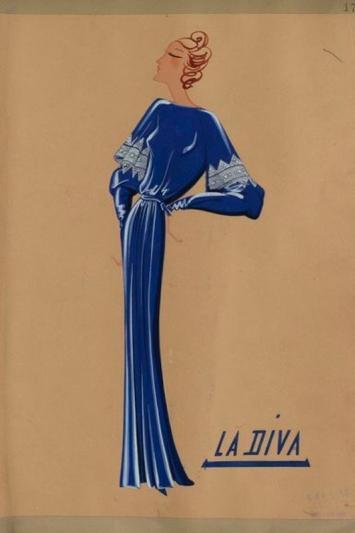#palais galliera
Just Blue
- Maison Lanvin illustration « La Diva », winter 1935-1936.
- « La Diva », evening gown, winter 1935-1936, silk velvet, Collection Palais Galliera.
- Yves Klein, Anthropometries of the Blue Period, 1962.
Post link
The very surprising and brief return of the crinoline, 1920-30
A brief fashion was the return of the crinoline in the 1920s. In a period dominated by women abandoning their corsets and stiffened underskirts to instead don the tubular shapes, this is an example of different trends living side by side.
The 1910s also saw experiments with hip shapening, especially through Paul Poiret’s “Lamp Shade Tunic” (Sorbet) in 1913. But this was a part of his interest in theatrical “oriental” garments like the harem pants, turbans and Ballet Russe ensembles, and not necessarily something that widely caught on.
Many of the 1920s “crinoline” gowns were court gowns of different kinds, but with the amount in existence in museums around the world it appears the style was also adapted for non-court wear. It’s often referred to as “Robe de Style”.
- Evening/court gown, ca. 1920, Boué Soeurs (with embroidery by Lesage). Kunstindustrimuseet/Design Museum Denmark, Copenhagen ( X).
- Court presentation ensemble, 1928, The Metropolitan Museum of Arts, NYC (C.I.68.48a–e).
- Evening gown, 1920s, The Metropolitan Museum of Arts, NYC ( X).
- Same as no. 2, without train.
- Robe de Style, 1929, by the Boué Soeurs ( X)
- Same as no. 2, back
- Court presentation ensemble, 1932-34 (?), Boué Soeurs. The Metropolitan Museum of Arts, NYC (2009.300.1251ab).
- Evening/court gown, ca. 1920, Boué Soueurs. Worn by Countess Astrid Ahlefeldt-Laurvig. The skirt width indicates a stiffened underskirt would have been worn originally, and with it the dress would have been near identical to no. 3 and no. 8. Holbæk Museum, Denmark ( X).
- Evening/court gown, 1925-28, Boué Soeurs. Palais Galliera, Paris ( X).
Post link
Gabrielle Chanel, Spring–Summer Dress, 1960,
Embroidered Cotton Tulle, Lamé, Organdie,
Palais Galliera, Paris,
Gift of Chanel Photo
© Julien T. Hamon
Post link











